We may earn a commission when you click on the affiliate links in this post.
Tomatoes are one of the most important ingredients in Italian cooking. In Italy, buying authentic canned Italian tomatoes is easy. However, in the United States, it is much more difficult. We will teach you everything you need to know about finding the perfect canned tomatoes and how to avoid the knock-offs.
Use this guide when making all sorts of Italian recipes. Or, if you want to grow your own plump tomatoes, check out our tips and tricks for growing the best tomatoes! Want to learn how to can your own tomatoes? Gather your canning jars and we can walk you through the process in this handy guide.
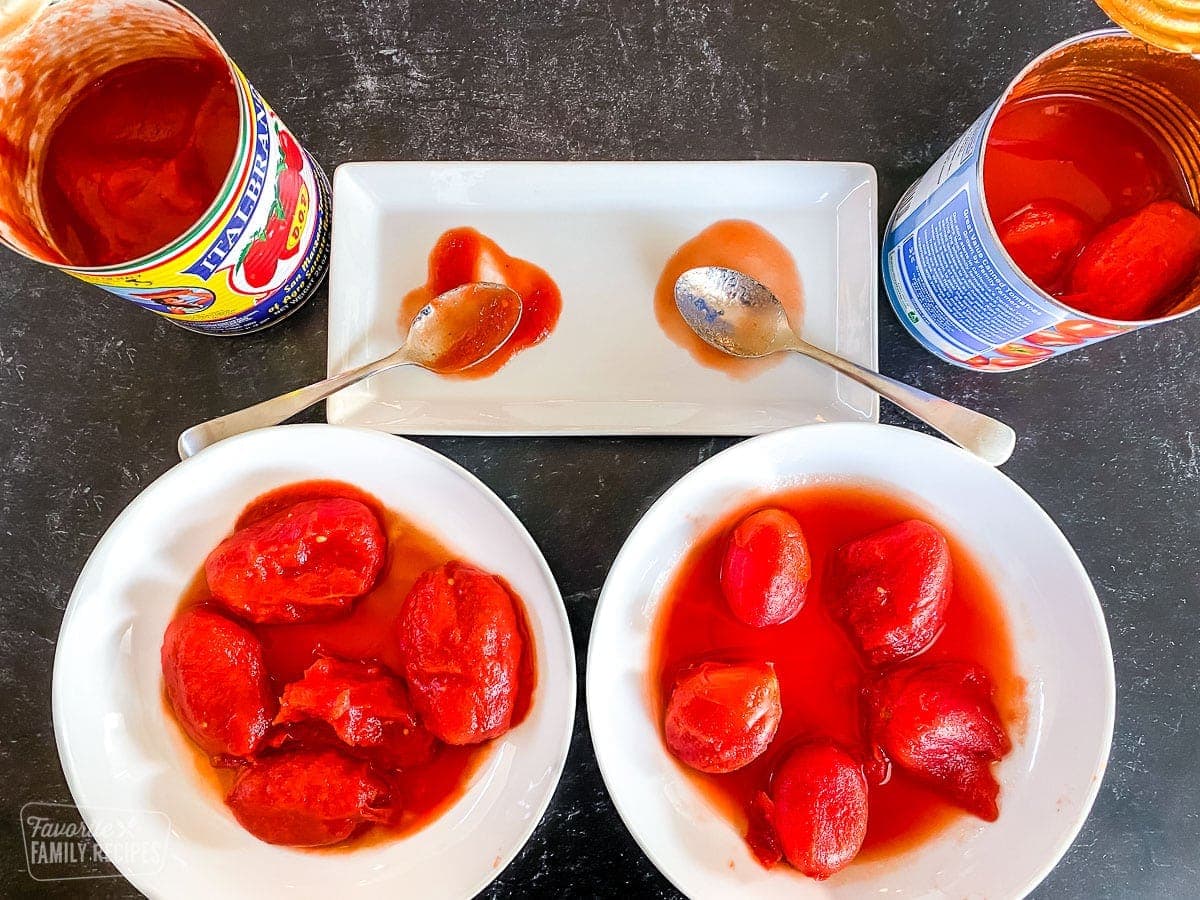
Featured with this post
When it comes to canned tomatoes, the best tomatoes come from Europe. We can say this confidently. How? Because we actually WENT to Italy and saw for ourselves. It was an exciting adventure and we learned so much about authentic Italian canned tomatoes. We visited the Ciao tomato processing plant outside of Naples, Italy, and witnessed the magic happen. We even got to wear this super cute protective gear.
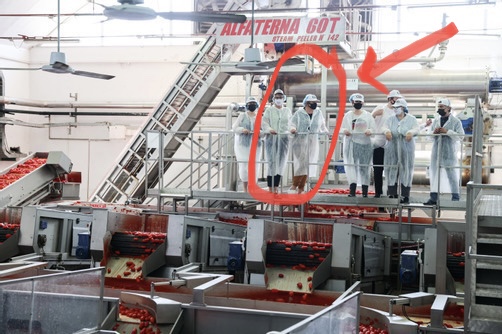
The Associazione Nazionale Industriali Conserve Alimentari Vegetali aka ANICAV (or in English, The National Association of Vegetable Preserves) invited us to Italy to see their process. Their goal is to spread the word to U.S. consumers about the high-quality tomatoes from Europe and why it’s worth it to get the real deal. However, it didn’t take much convincing. The tomatoes spoke for themselves.
Canned Tomatoes Vs. Fresh Tomatoes
As you may know, we love growing tomatoes. Nothing quite beats a fresh, home-grown tomato straight from the garden. However, the tomato growing season in the U.S. is short, on average just 3-4 months. This makes it difficult to enjoy garden tomatoes year round. Also, fresh tomatoes may not be the easiest (or best) for certain dishes. When it comes to pasta sauces, pizza sauces, purees, and soups, the chefs in Italy prefer using the whole canned varieties.
Not only are canned tomatoes easier to use and more accessible year round, but they have been packed in pure tomato puree (and sometimes a large basil leaf) helping to bring out the rich flavor of the Italian-grown tomatoes.
Canned tomatoes can taste a whole lot better than fresh ones in all kinds of recipes. The key is choosing the right kind.
Why Canned Tomatoes From Italy?
For the best tomatoes, you can bottle or can your own homegrown tomatoes (we have a recipe on how to do this) or you can glean from the rich, bountiful tomato crops from the fertile, volcanic soil that rests at the base of Mt. Vesuvius in Italy.
The Ciao factory we toured is located right in the foothills of Mt. Vesuvius in the San Marzano region of Italy. The whole peeled tomatoes are the pride of Ciao and are produced specifically to meet the needs of chefs and Pizzaiolos – chefs who have been trained and specialize in making real, Italian-style pizzas.
Astonishingly, at Ciao, a sun-ripened San Marzano tomato is picked from the field, washed, peeled, and canned within 6 hours! No wonder the taste is so incredible!
Close to the Ciao factory is the Calispa tomato production factory. Our good friend, Jeanne Fratello, author of the Jolly Tomato, toured the Calispa factory which also produces the San Marzano tomato. You can read about her experience at Calispa at jollytomato.com.
Tomato Processing at Ciao
Witnessing the processing of the San Marzano tomatoes was fascinating to say the least. They take such great care in how they process the tomatoes. They key is to processes the tomatoes as little as possible to keep the quality and integrity of each tomato. Allow me to take you on a little tour.
Washing and Sorting
The tomatoes arrive at the factory and then go through the washing process twice.
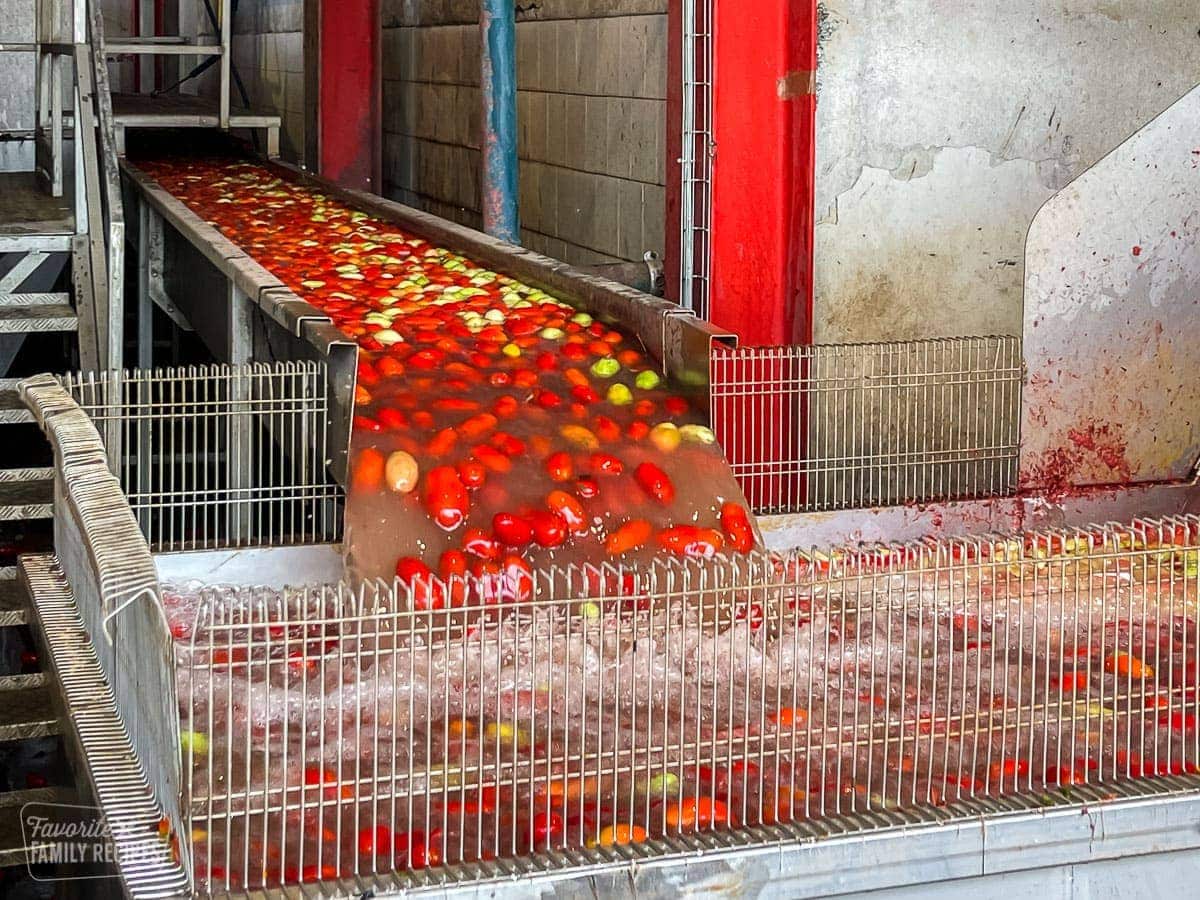
A special sorting machine removes the green tomatoes from the red ones. The green ones go in a separate container set aside for animal feed.
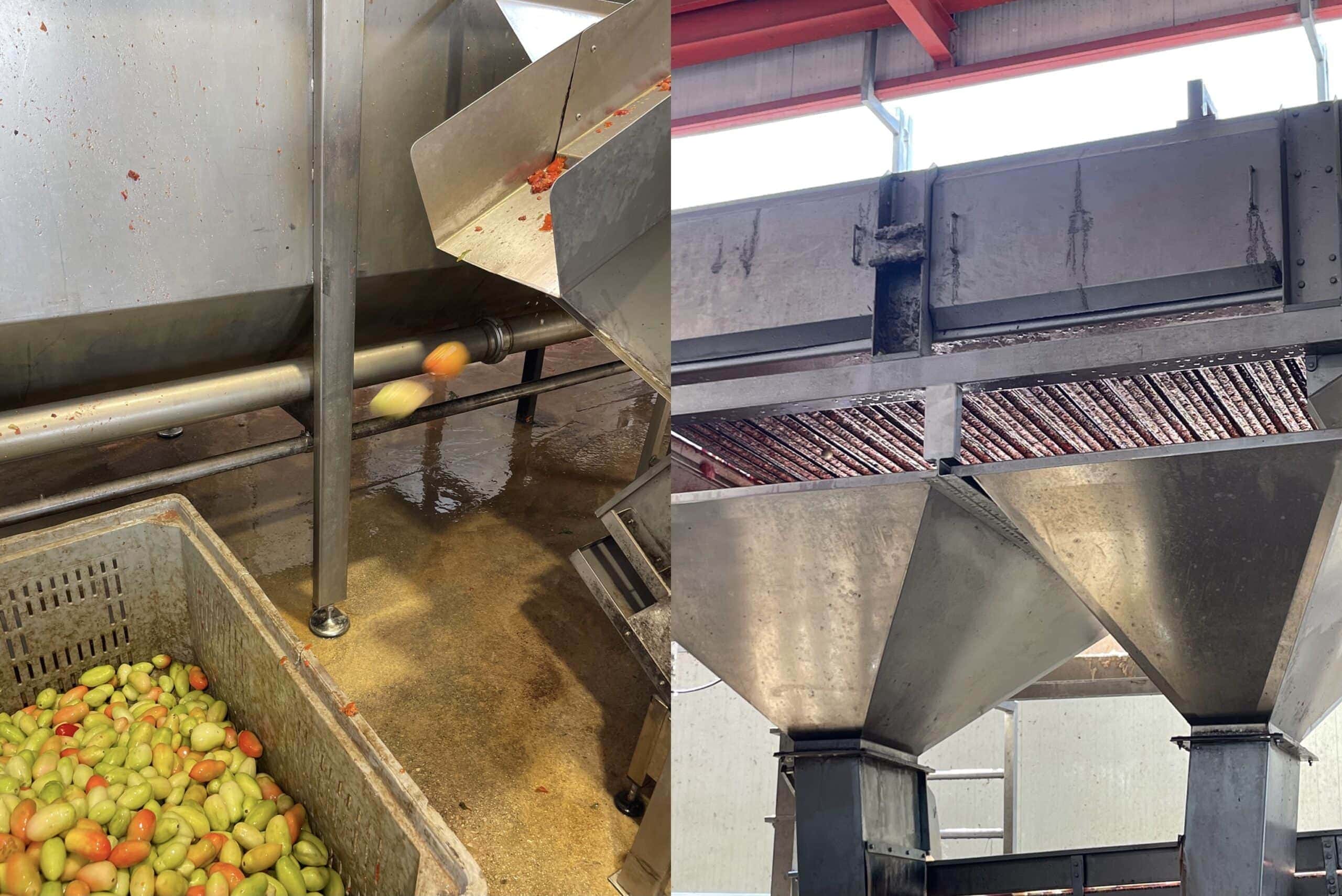
Nothing goes to waste at Ciao. The facility recycles all the water and even the dirt. After the tomatoes have been washed in the water bath, the water goes through a thorough purification process to be re-used. The dirt that has been rinsed from the tomatoes is removed and SAVED to be taken back to toss into the tomato fields. These growers know the value of the soil and they don’t waste any of it.
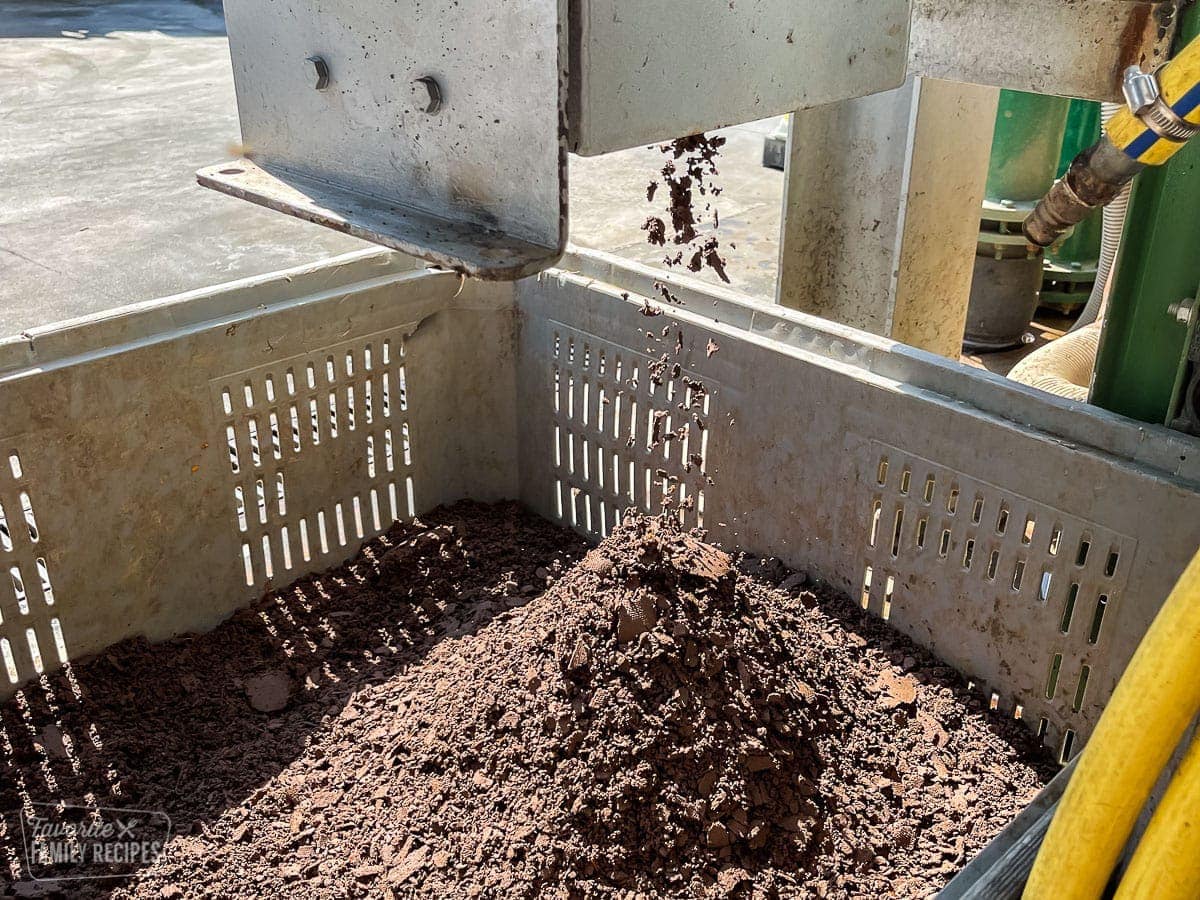
Steaming and Peeling
Next, the tomatoes are steamed in boiling water. Then, these textured rollers remove the skins. Next, the skins, stems, and juices from the ripe tomatoes go in another container set aside for compost.
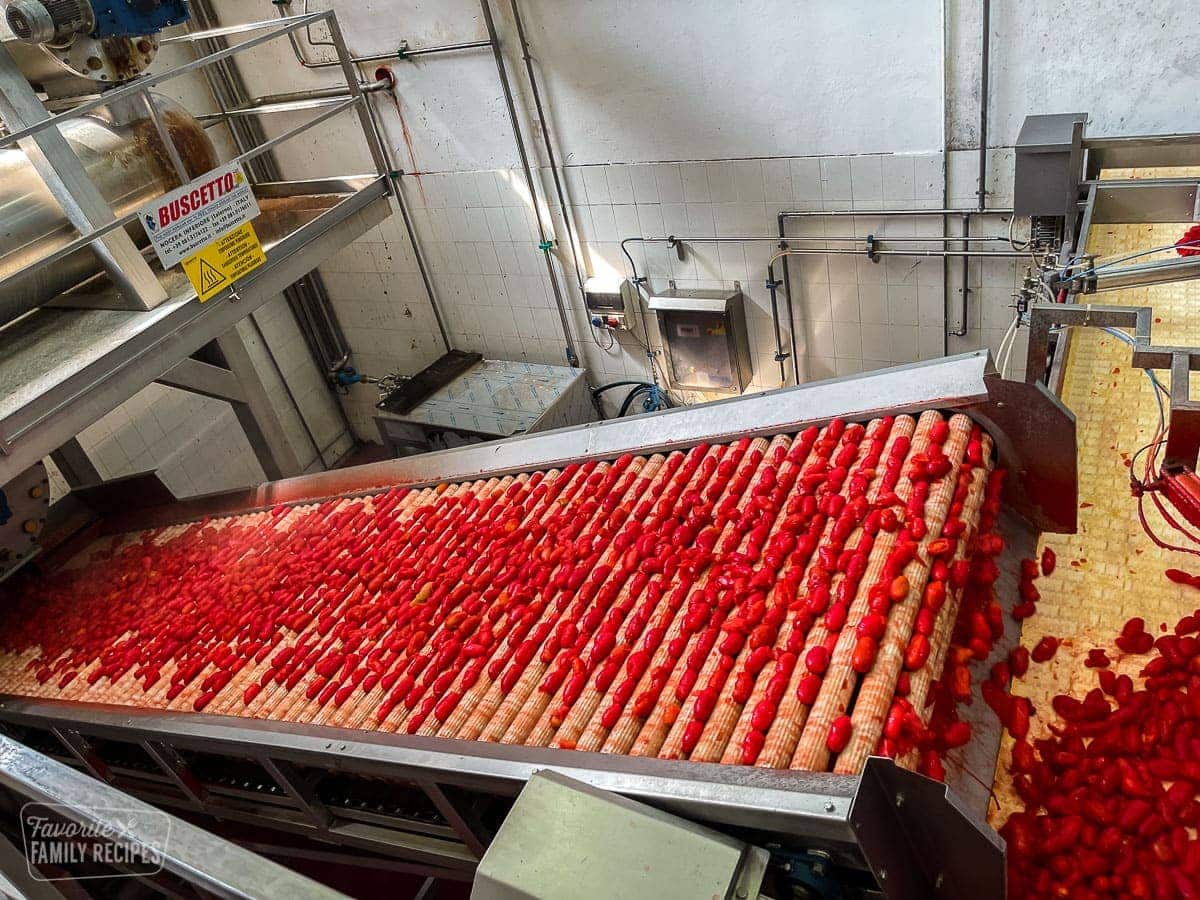
Hand Picking Only the Best
Then, the workers sort the tomatoes by hand. Only the best of the best are left whole to be put in the cans. Next, the rest of the tomatoes are pureed and then added or used separately. Each batch of tomatoes that comes in is tested and re-tested for quality by special labs within the factory.
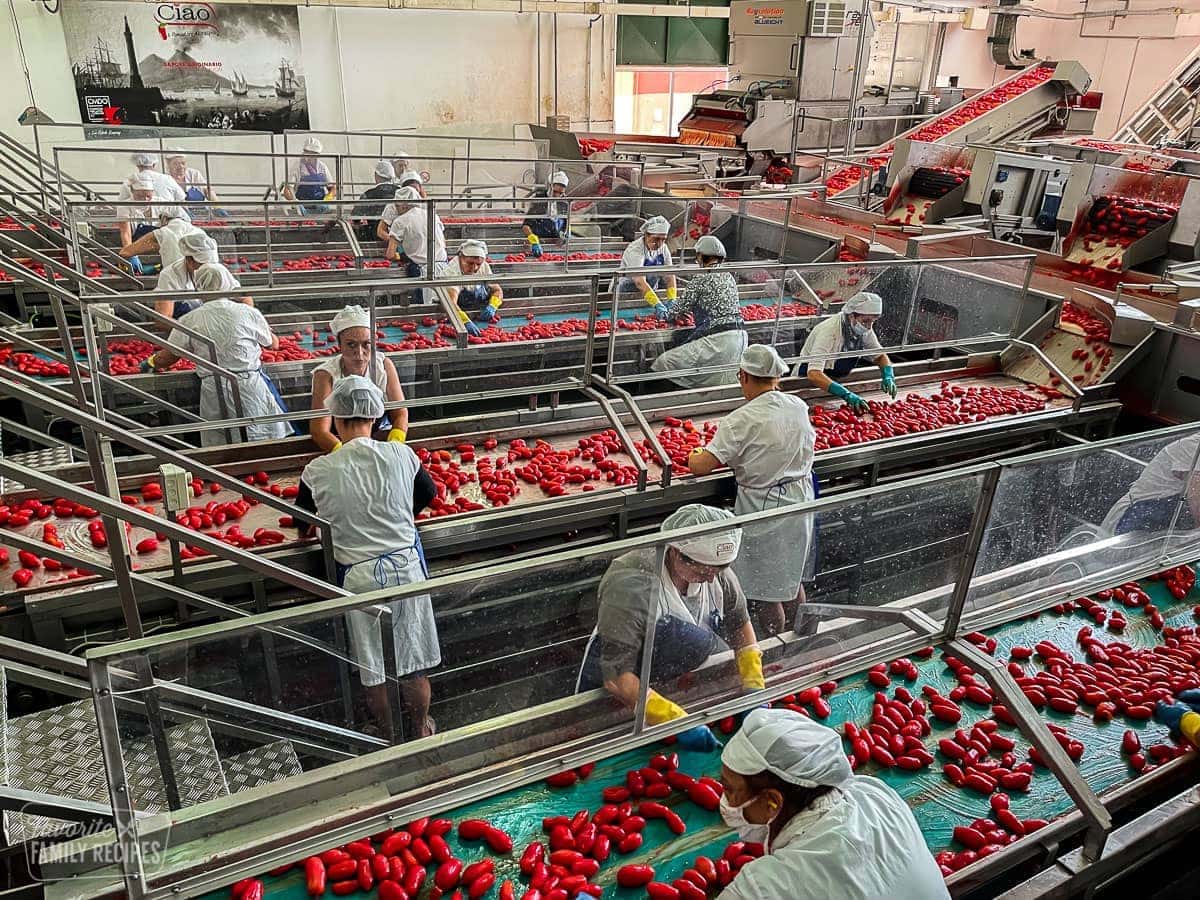
The Finished Product
Then, sometimes a large basil leaf is added to the can for flavor, but other than that, the process is finished. Nothing else is added. Not hot water, not lemon juice, not salt, herbs, oregano, garlic, peppers or onions – nothing.
Those cans are just filled to the rims with pure tomatoes.
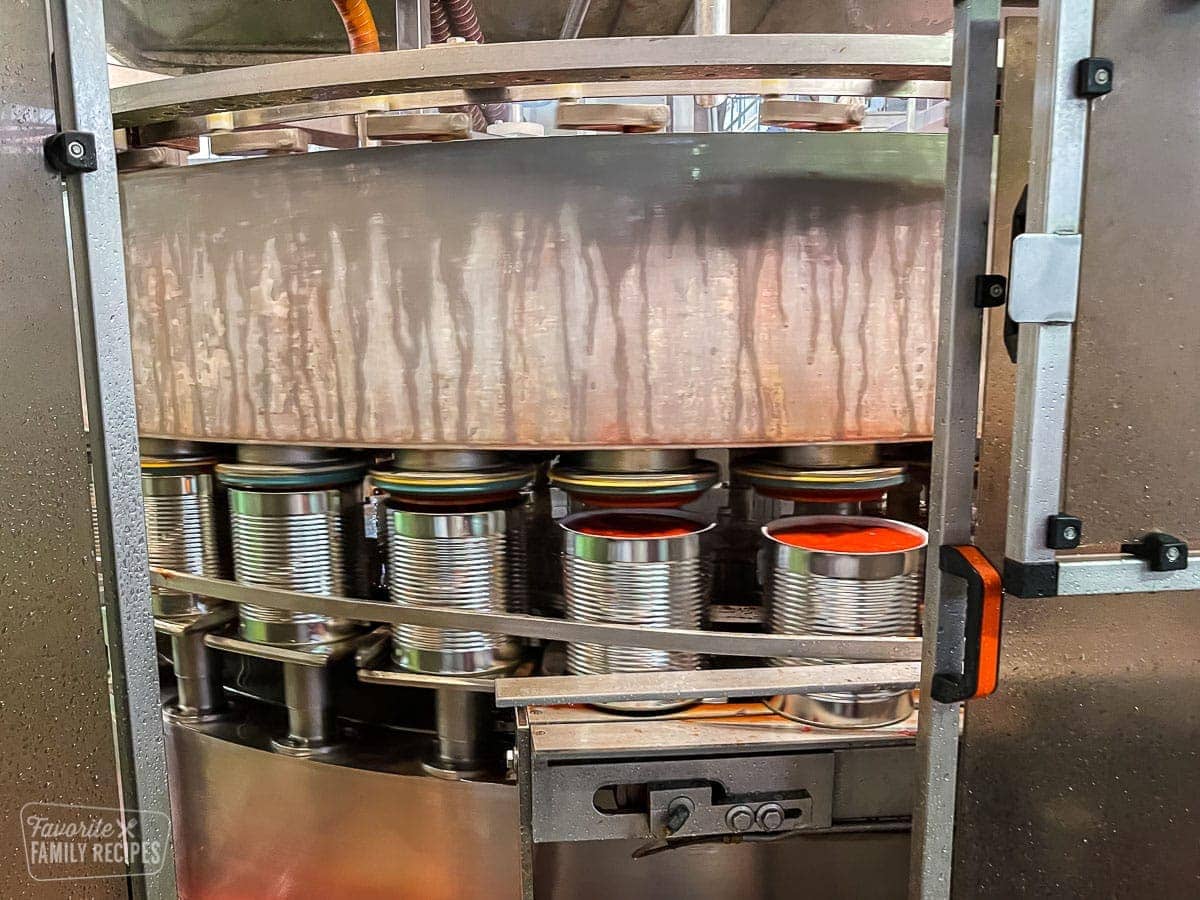
Our guides showed us two samples of the tomatoes. One sample of the tomatoes before processing and one after processing. Can you see the difference? Neither could we. They look, smell, and taste the same.
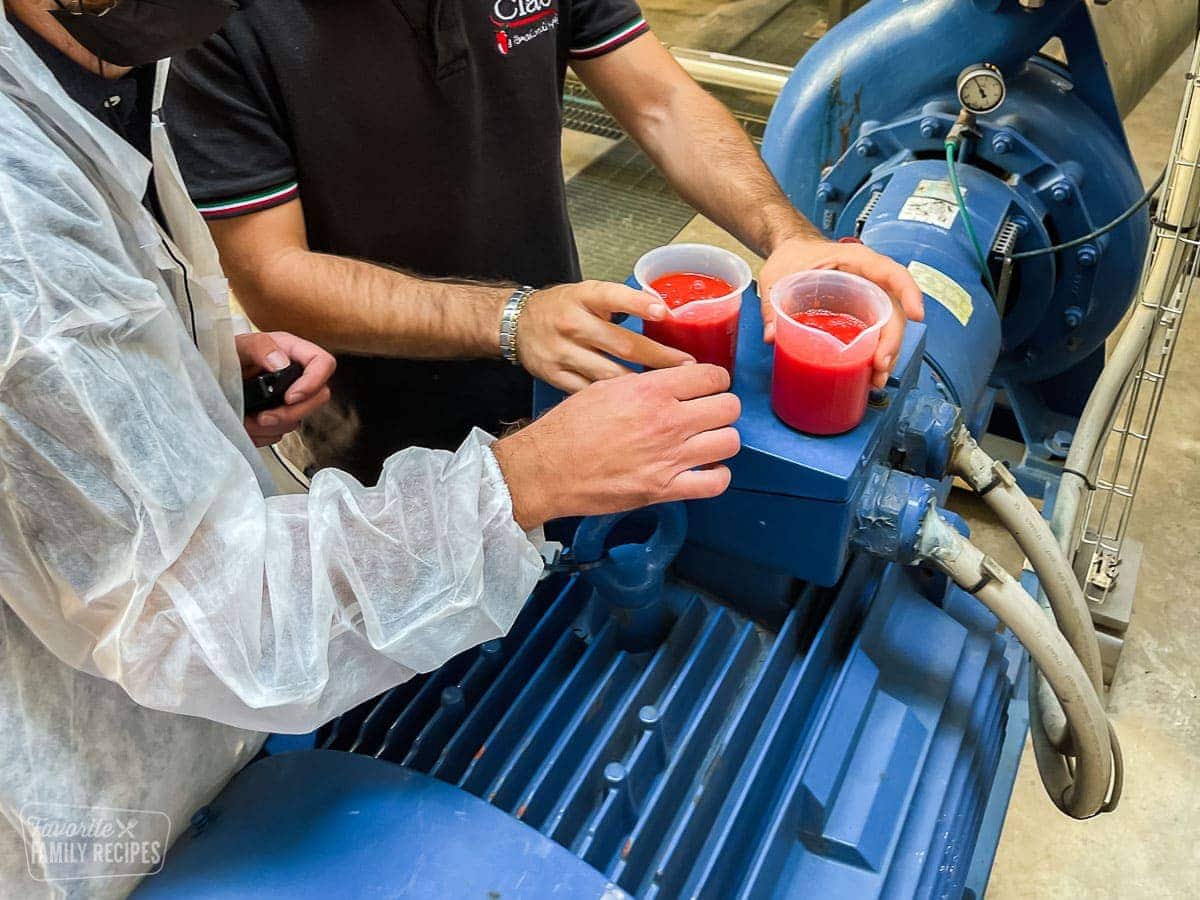
Buying An Italian Brand of Canned Tomatoes
Knowing what we know now, you may ask, “Yeah but is it worth it? Can you actually tell a difference?” The answer is YES. As soon as I got home, I did my own tests. If you are wanting to make true, authentic Italian dishes, or if you just want to take your pizza sauce, chili, or pasta recipes to the next level, it is absolutely worth it to spend a little more and buy an actual brand from Italy. But use caution, plenty of knock offs hide under lids on the store shelves. If you want the best, you need to know the difference.
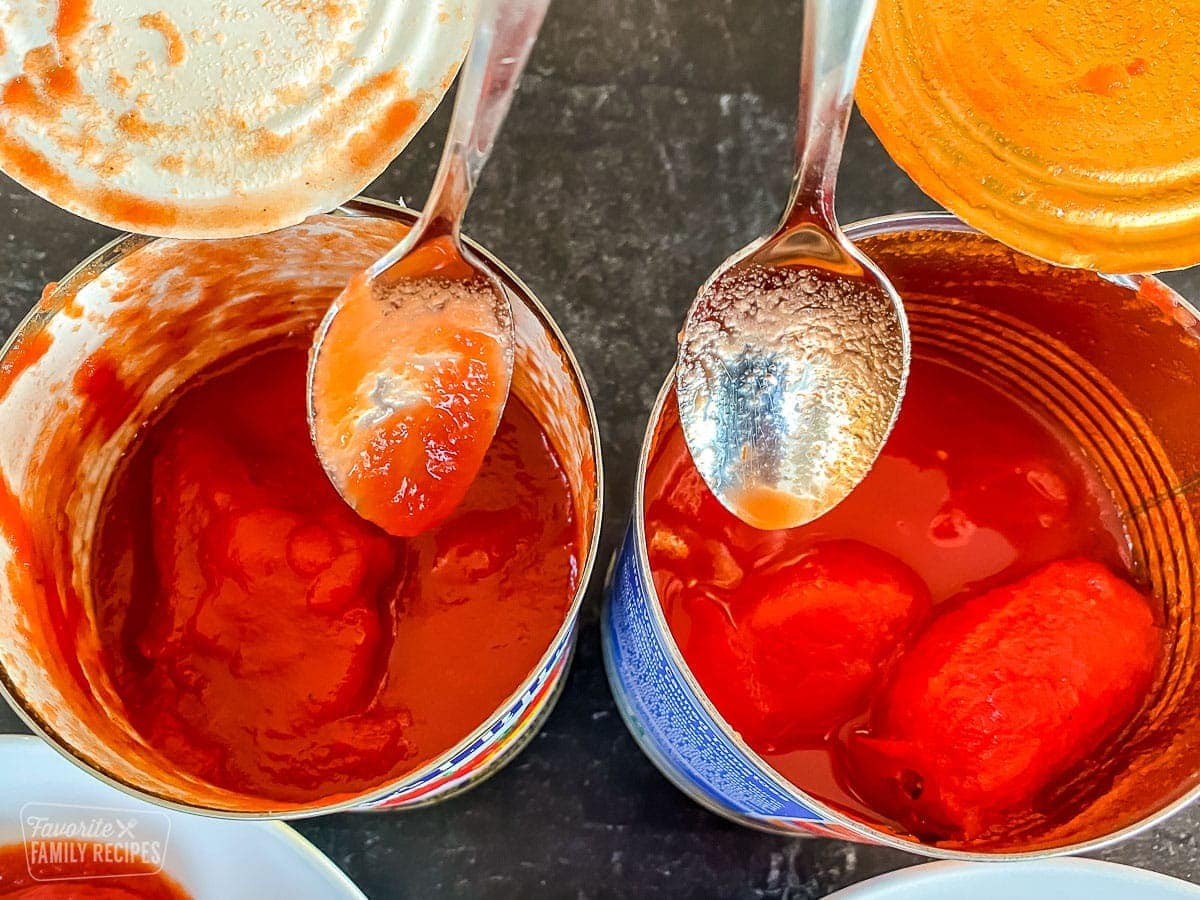
How To Find Genuine Italian Canned Tomatoes
Some canned tomatoes are clearly not from Italy. With others, it can be hard to tell. We will teach you how to find the real deal and how to spot the fakes.
- First, check the labels. First, does it say “Product of Italy” or “Certified Product of Italy”? That is the first thing you can look for. It also helps if some of the words are in Italian. Look for the words “pomodoro” or “pomodori”, which is “tomato” in Italian.
- Next, look at the ingredients. In Italy they don’t add extra ingredients or preservatives to the tomatoes. You can see below, the Italian tomatoes JUST have whole, peeled tomatoes and tomato puree. However, on the right we have salt, calcium chloride, and citric acid.
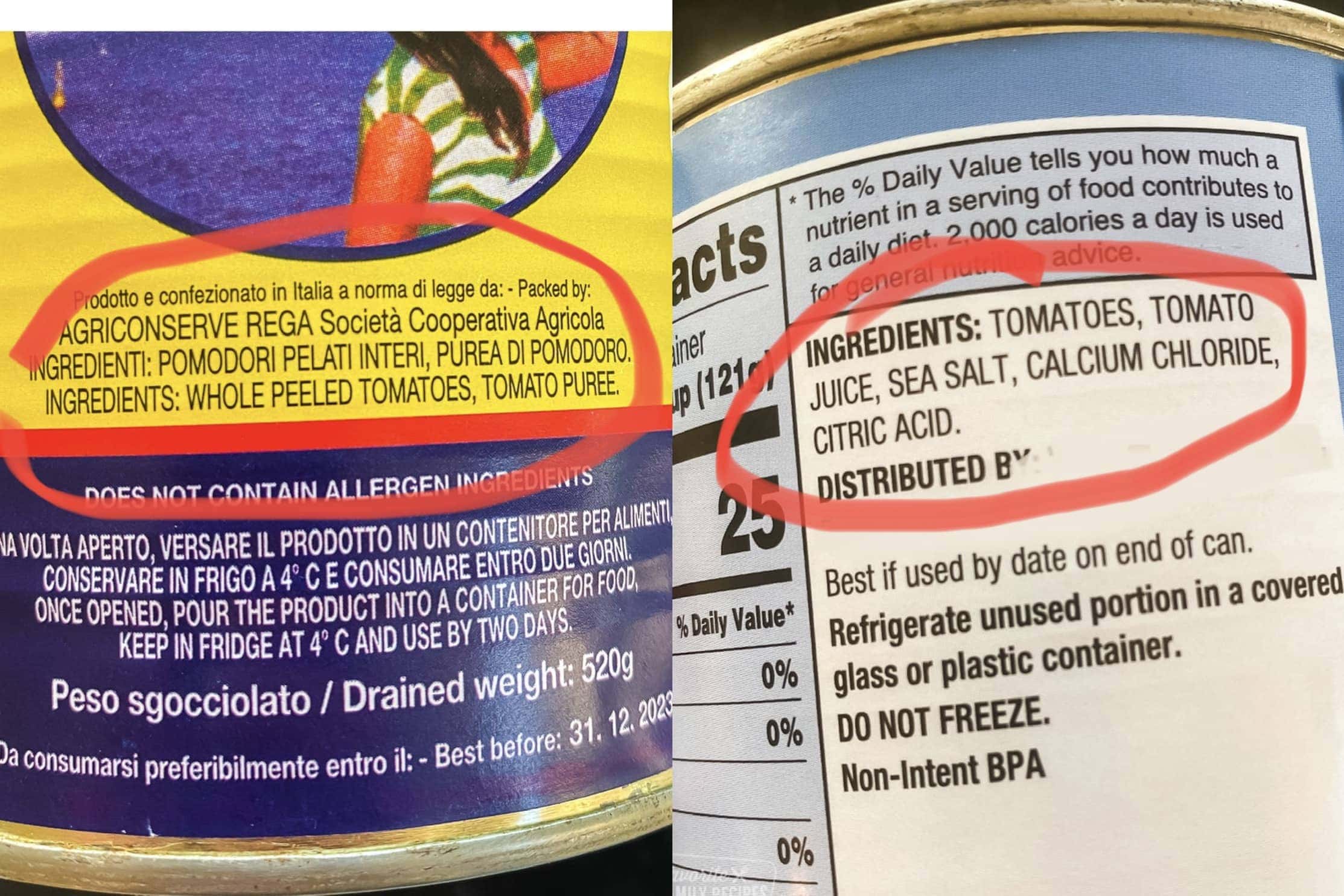
These next two “tells” are specifically for finding authentic “San Marzano” tomatoes, which is what many of you are wanting when it comes to Italian tomatoes.
- Look for the symbol that says: “Pomodoro San Marzano dell’Agro Sarnese Nocerino D.O.P.” This confirms that the tomatoes are from the Agro Nocerino Sarnese region of Italy. For example, you can see this symbol in the picture below.
- Next, look for the DOP seal and serial number. This one is a biggie. Probably the biggest “tell” of them all when it comes to authentic San Marzano tomatoes. I will explain more below, but here is an image of what the DOP seal looks like:
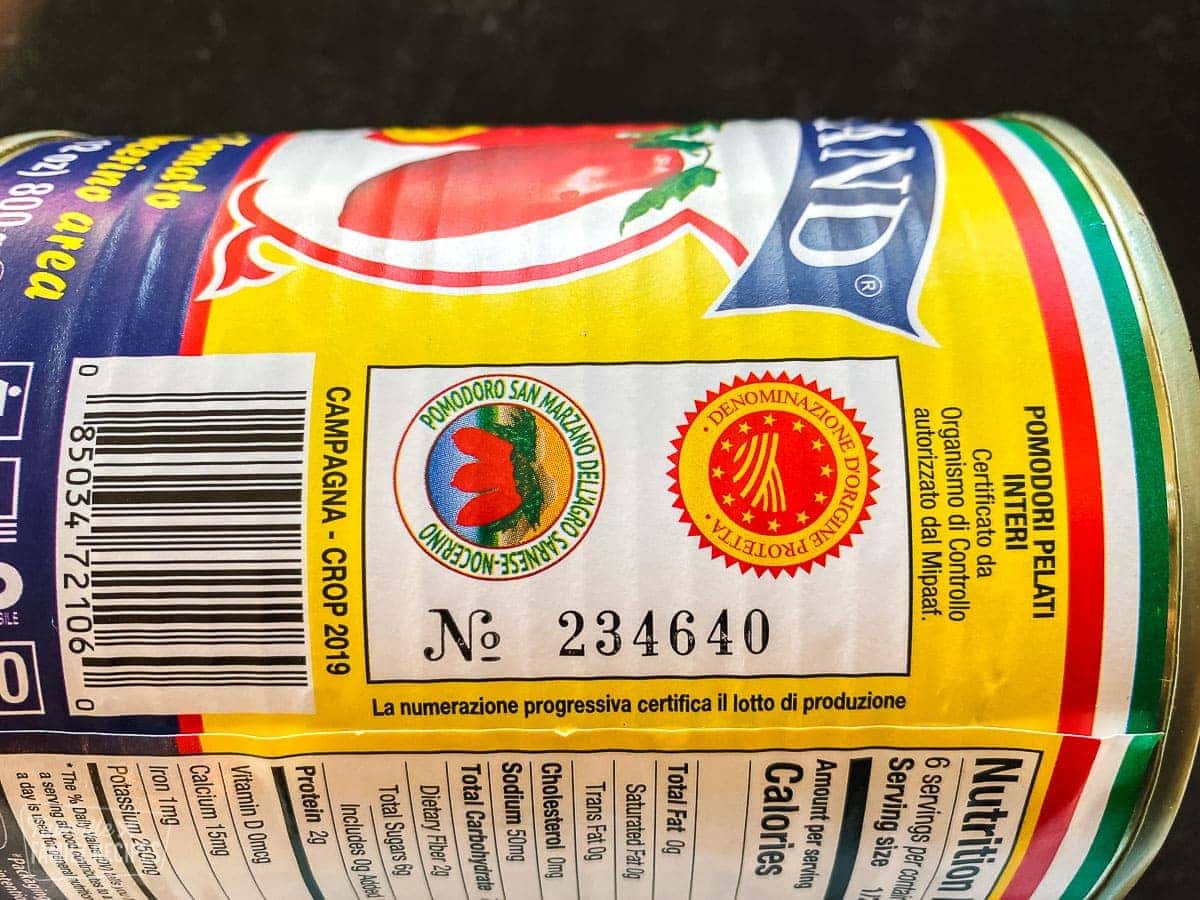
D.O.P.: What it means and Why It Matters
D.O.P. stands for “Denominazione d’ Origine Protetta”. Translated to English it means “Protected Designation of Origin”. The DOP symbol is a legally registered trademark that identifies regional European food products that are protected by law. In a nutshell, it guarantees by law that you are getting exactly what you expect to be getting and that it’s coming from where it says it’s coming from. This is a big deal in Italy. From buffalo mozzarella, to hazelnuts, to parmesan cheese, it is very important to know that what you are consuming is from the EXACT region of Italy that it is known for. It guarantees the best quality and authenticity.
For example, the symbol above guarantees that these San Marzano tomatoes are BOTH of the San Marzano variety AND grown and processed in the San Marzano region. Another example is “Parmesano Reggiano”– this is Parmesan cheese from the region of “Parma” in Italy. With the DOP seal you can be certain that you are getting the REAL DEAL. Now that you know what to look for, keep an eye out for it!
Spotting The Fakes
Did you know that 95% of “Italian” tomatoes in the United States are knock-offs? In the United States, a company can say they are “San Marzano” tomatoes, yet they grow and process their tomatoes in California or Chicago or wherever they want. As real Italian canned tomatoes increasingly appear in the United States, so do the fakes. Avoid the fakes by looking for these red flags:
- “San Marzano “Style” Tomatoes“: When browsing through my local grocery store, I couldn’t believe how many cans of tomatoes I found that said they were San Marzano “style”. But, what does that even MEAN? When checking the labels I noticed they came from pretty much everywhere BUT Italy.
- “A Product Of California” (or any other state in the US) If it is a product of California, it is not a product of Italy.
- “Diced”, “Chopped”, “Crushed”, “Puree”: If you see these words, walk away. In Italy, they take pride in processing the tomatoes as LITTLE as possible. Dicing, crushing, or pureeing the tomatoes adds an extra step and is not a common practice in Italian factories.
- “Organic”: Italy does not regulate “organic” labels. The DOP guidelines are held in higher regard by Italians than the “organic” guidelines set by the United States.
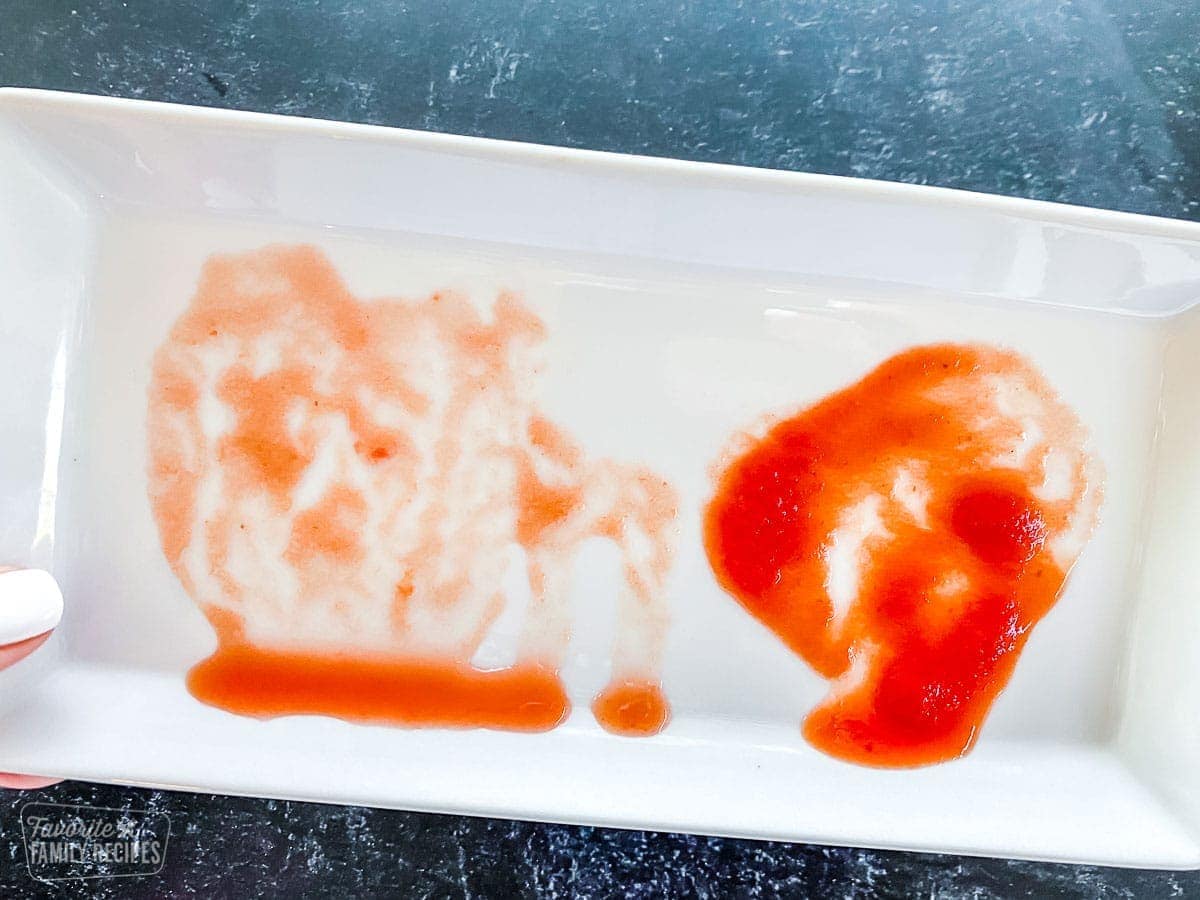
Where It Gets Tricky
To be clear, just because a can of tomatoes doesn’t have the DOP label doesn’t mean it’s not from Italy. This is where it gets tricky. The DOP label applies only to San Marzano tomatoes. But what about canned plum or Roma tomatoes from Italy? For example, the Ciao factory that we visited has the same process for ALL of their tomatoes, and they are ALL delicious Italian tomatoes from the Agro Nocerino Sarnese region of Italy. However, many of their products don’t have the DOP label because they aren’t ALL of the “San Marzano” variety. However, there’s two easy ways to know the difference:
- Work backwards: If a tomato brand has the DOP label on any of their products, you can safely conclude that they are a trusted brand. They most likely have many other products that aren’t “San Marzano DOP” but still from Italy and processed the same way. “Ciao” brand is one of those brands.
- Finally, check the ANICAV Website (use the Google translate plugin on Chrome to translate to English): this is the full list of ANICAV associated companies. This is a full, comprehensive list of certified tomato companies in Italy.
FAQ’s
Yes! All the time. We took a cooking class from an Italian chef in Naples and he prefers using whole, canned tomatoes for his pizza sauce. He simply crushes the whole tomatoes into a sauce before adding it to the pizza.
Usually canned tomatoes are steamed just long enough to get the peels off before they are canned at the factories. If canning tomatoes at home, they will be cooked a little bit while they are being processed.
It says it right on the can. Most cans nowadays are BPA free but check the label to be sure.
What Can I Do With Canned Tomatoes?
Okay, so now you know ALL about canned tomatoes. Finally, you are now ready to go out and start making some recipes! You can use canned tomatoes in any of these recipes below:
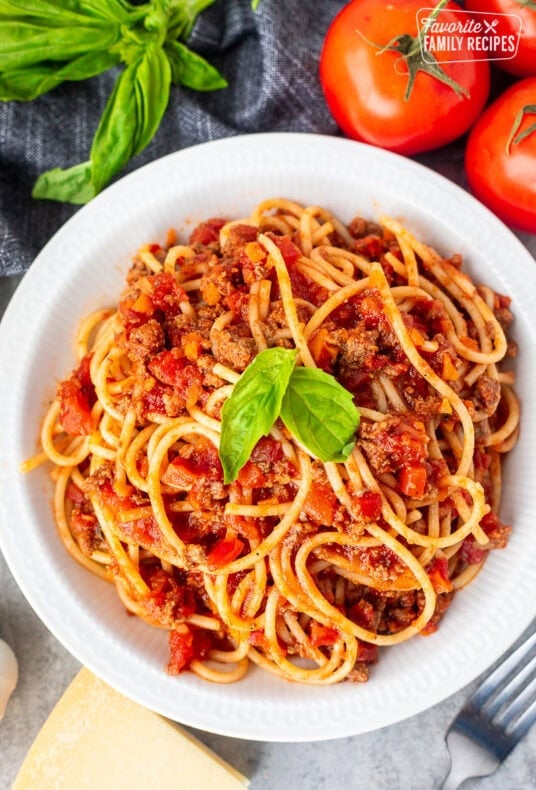

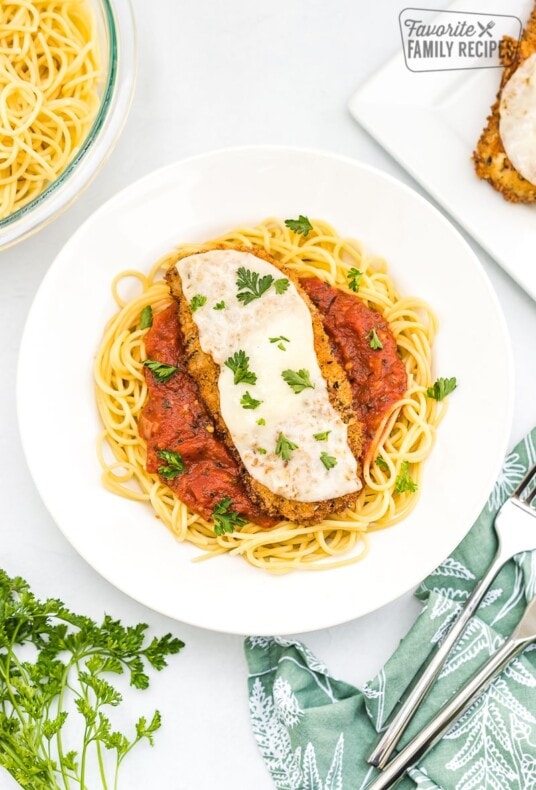

Great article but where can one purchase these Italian Roma tomatoes in cans?
Thank you for asking, Dave. Walmart and Costco usually carry the DOP Italian tomatoes. Just check the labels. Cento, La Valle, and Delallo are common brands that can be found in the U.S. You can also find them at World Market and Italian grocery stores.
Great article. I’m very well knowledged on tomatoes from Italy and this article is a great read for anyone looking to educate themselves and get a better understanding of a real canned tomato. Sorry folks Cali ain’t it. If your tomatoes come from Cali they most likely no longer taste like a true tomato due to carrot juice or other additives . Only canned tomatoes you want are from Italy. The extra money you spend is well worth it. D.o.p. is definitely the way to go. One of my favorite tomatoes is probably the best in the world. Mutti. I highly recommend. Also the links you provided in this article is another great item to this article. Well done. Very well done
Great information for best canned tomatoes!!
This is a great post! Super helpful and informative! I love seeing the comparison of the “sauce” that the tomatoes are packed in, and yes, I definitely want the thicker, richer one! It was great to experience this trip with you and I look forward to seeing more of your tomato recipes!